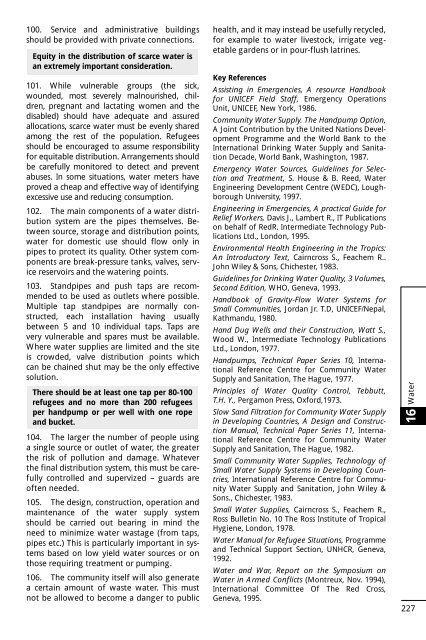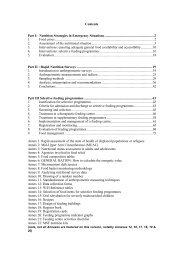UNHCR Handbook for Emergencies - UNHCR eCentre
UNHCR Handbook for Emergencies - UNHCR eCentre
UNHCR Handbook for Emergencies - UNHCR eCentre
Create successful ePaper yourself
Turn your PDF publications into a flip-book with our unique Google optimized e-Paper software.
100. Service and administrative buildings<br />
should be provided with private connections.<br />
Equity in the distribution of scarce water is<br />
an extremely important consideration.<br />
101. While vulnerable groups (the sick,<br />
wounded, most severely malnourished, children,<br />
pregnant and lactating women and the<br />
disabled) should have adequate and assured<br />
allocations, scarce water must be evenly shared<br />
among the rest of the population. Refugees<br />
should be encouraged to assume responsibility<br />
<strong>for</strong> equitable distribution. Arrangements should<br />
be carefully monitored to detect and prevent<br />
abuses. In some situations, water meters have<br />
proved a cheap and effective way of identifying<br />
excessive use and reducing consumption.<br />
102. The main components of a water distribution<br />
system are the pipes themselves. Between<br />
source, storage and distribution points,<br />
water <strong>for</strong> domestic use should flow only in<br />
pipes to protect its quality. Other system components<br />
are break-pressure tanks, valves, service<br />
reservoirs and the watering points.<br />
103. Standpipes and push taps are recommended<br />
to be used as outlets where possible.<br />
Multiple tap standpipes are normally constructed,<br />
each installation having usually<br />
between 5 and 10 individual taps. Taps are<br />
very vulnerable and spares must be available.<br />
Where water supplies are limited and the site<br />
is crowded, valve distribution points which<br />
can be chained shut may be the only effective<br />
solution.<br />
There should be at least one tap per 80-100<br />
refugees and no more than 200 refugees<br />
per handpump or per well with one rope<br />
and bucket.<br />
104. The larger the number of people using<br />
a single source or outlet of water, the greater<br />
the risk of pollution and damage. Whatever<br />
the final distribution system, this must be carefully<br />
controlled and supervized – guards are<br />
often needed.<br />
105. The design, construction, operation and<br />
maintenance of the water supply system<br />
should be carried out bearing in mind the<br />
need to minimize water wastage (from taps,<br />
pipes etc.) This is particularly important in systems<br />
based on low yield water sources or on<br />
those requiring treatment or pumping.<br />
106. The community itself will also generate<br />
a certain amount of waste water. This must<br />
not be allowed to become a danger to public<br />
health, and it may instead be usefully recycled,<br />
<strong>for</strong> example to water livestock, irrigate vegetable<br />
gardens or in pour-flush latrines.<br />
Key References<br />
Assisting in <strong>Emergencies</strong>, A resource <strong>Handbook</strong><br />
<strong>for</strong> UNICEF Field Staff, Emergency Operations<br />
Unit, UNICEF, New York, 1986.<br />
Community Water Supply. The Handpump Option,<br />
A Joint Contribution by the United Nations Development<br />
Programme and the World Bank to the<br />
International Drinking Water Supply and Sanitation<br />
Decade, World Bank, Washington, 1987.<br />
Emergency Water Sources, Guidelines <strong>for</strong> Selection<br />
and Treatment, S. House & B. Reed, Water<br />
Engineering Development Centre (WEDC), Loughborough<br />
University, 1997.<br />
Engineering in <strong>Emergencies</strong>, A practical Guide <strong>for</strong><br />
Relief Workers, Davis J., Lambert R., IT Publications<br />
on behalf of RedR. Intermediate Technology Publications<br />
Ltd., London, 1995.<br />
Environmental Health Engineering in the Tropics:<br />
An Introductory Text, Cairncross S., Feachem R..<br />
John Wiley & Sons, Chichester, 1983.<br />
Guidelines <strong>for</strong> Drinking Water Quality, 3 Volumes,<br />
Second Edition, WHO, Geneva, 1993.<br />
<strong>Handbook</strong> of Gravity-Flow Water Systems <strong>for</strong><br />
Small Communities, Jordan Jr. T.D, UNICEF/Nepal,<br />
Kathmandu, 1980.<br />
Hand Dug Wells and their Construction, Watt S.,<br />
Wood W., Intermediate Technology Publications<br />
Ltd., London, 1977.<br />
Handpumps, Technical Paper Series 10, International<br />
Reference Centre <strong>for</strong> Community Water<br />
Supply and Sanitation, The Hague, 1977.<br />
Principles of Water Quality Control, Tebbutt,<br />
T.H. Y., Pergamon Press, Ox<strong>for</strong>d,1973.<br />
Slow Sand Filtration <strong>for</strong> Community Water Supply<br />
in Developing Countries, A Design and Construction<br />
Manual, Technical Paper Series 11, International<br />
Reference Centre <strong>for</strong> Community Water<br />
Supply and Sanitation, The Hague, 1982.<br />
Small Community Water Supplies, Technology of<br />
Small Water Supply Systems in Developing Countries,<br />
International Reference Centre <strong>for</strong> Community<br />
Water Supply and Sanitation, John Wiley &<br />
Sons., Chichester, 1983.<br />
Small Water Supplies, Cairncross S., Feachem R.,<br />
Ross Bulletin No. 10 The Ross Institute of Tropical<br />
Hygiene, London, 1978.<br />
Water Manual <strong>for</strong> Refugee Situations, Programme<br />
and Technical Support Section, <strong>UNHCR</strong>, Geneva,<br />
1992.<br />
Water and War, Report on the Symposium on<br />
Water in Armed Conflicts (Montreux, Nov. 1994),<br />
International Committee Of The Red Cross,<br />
Geneva, 1995.<br />
Water<br />
16<br />
227



